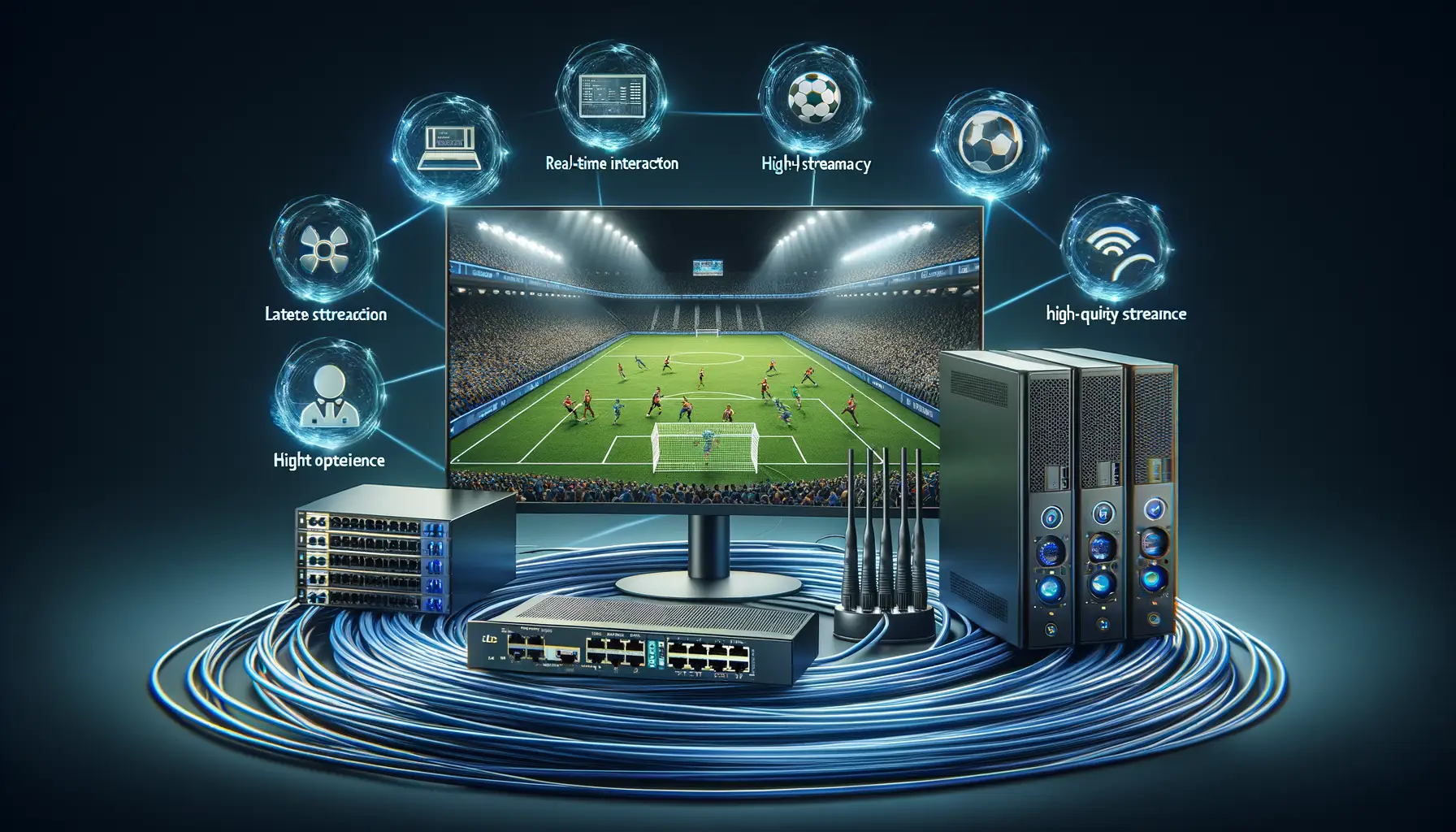Understanding Low-Latency Streaming Protocols
Why Speed Matters: Breaking Down Low-Latency Streaming
Imagine watching the final seconds of a live soccer match: your team lines up for a penalty shot, and just as the ball soars toward the goal, the screen freezes or you’re hearing cheers from your neighbor before your stream catches up. Frustrating, right? That’s the problem low-latency streaming protocols are designed to solve—ensuring every kick, swing, and sprint is delivered in near real-time, no delays, no spoilers.
At its core, low-latency streaming is all about reducing delay to milliseconds between what cameras capture on the field and what you see on your screen. This isn’t just tech wizardry—it’s an engineering masterpiece fine-tuned for moments that demand immediacy. Unlike traditional streaming protocols that trade speed for quality, these nimble systems balance both, making sure the action lands in the moment it happens.
- Latency: The time between live action and when it appears on your device. Lower is always better.
- Adaptive Playback: Seamlessly adjusts to network hiccups without buffering.
- Interactivity: Enables real-time audience participation—think instant stats overlays or live polls.
With low-latency streaming, you’re not just watching sports; you’re *living* them, heartbeat by heartbeat.
Key Features and Benefits of Low-Latency Protocols in Sports Streaming

Why Speed Matters in Sports Streaming
Imagine this: It’s the final seconds of a heated basketball game. The score is tied, the crowd is roaring, and your favorite player makes a buzzer-beater shot. But wait—your stream lags just as the ball leaves their hands. Frustrating, right? This is where low-latency protocols come to the rescue, ensuring you experience the action as it happens, without delays that turn excitement into irritation.
What makes these protocols so revolutionary? They prioritize ultra-fast data transfer so there’s almost no delay between live events and what you see on your screen. In sports, every millisecond counts—not just for fans but also for betting platforms, commentators, and broadcasters who thrive on real-time precision.
- Stay ahead of spoilers: With minimal delay, no more social media ruining the game-winning moment!
- Enhanced interactivity: Engage with polls, stats, and live chats that sync perfectly with the match.
- Seamless streaming across devices: Watch on smartphones, TVs, or tablets without buffering nightmares.
Transforming the Way We Experience Sports
Low-latency streaming isn’t just a technical upgrade; it’s a game-changer for how we connect with sports. Ask any die-hard soccer fan—they’ll tell you hearing their neighbor cheer two seconds earlier can ruin even the most thrilling goal. With sub-second delivery speeds, streams now mirror the stadium’s tempo, making unpredictable plays all the more electrifying.
Broadcasters, too, are raising their game, offering features like multi-angle replays and real-time analysis that aren’t seconds behind but beat-for-beat accurate. The result? A smoother, more immersive experience that feels like you’re front row—even if you’re lounging on your couch.
Comparing Popular Low-Latency Streaming Protocols

Breaking Down the Giants: Protocols That Shape Real-Time Sports Streaming
When it comes to low-latency streaming protocols, the choices can feel a lot like picking your dream sports team. Each protocol has its star players and its unique strategies for winning the race against delay. Let’s dive into some of the key contenders and what they bring to the field.
WebRTC is like the sprinter of the bunch—blazing fast and ready to deliver real-time communication without overthinking it. It’s perfect for scenarios where speed is critical, like interactive sports coverage or fan engagement during live games. However, while it’s lightning-fast, WebRTC can struggle when scaling up to larger audiences.
Then we’ve got SRT (Secure Reliable Transport), the well-rounded all-star. Known for combining reliability with efficiency, SRT shines at delivering high-quality streams under unpredictable network conditions. Imagine it as your sturdy midfielder, keeping everything steady and coordinated—even when the WiFi tries to throw in a curveball.
- HLS (HTTP Live Streaming): It’s dependable but not exactly built for speed. Think marathon runner, slow yet tireless.
- RIST (Reliable Internet Stream Transport): The underdog, quietly offering robust reliability with a lower profile.
The choice? It depends on your playstyle—whether you prioritize blazing speed, rock-solid stability, or a blend of both.
Challenges and Solutions in Implementing Low-Latency Streaming for Sports

The Hurdles of Achieving Real-Time Sports Streaming
Picture this: a massive crowd glued to their screens, cheering for their favorite soccer team, and suddenly… the stream lags. That heart-stopping goal? Completely ruined by buffering. The world of low-latency streaming in sports isn’t a walk in the park—it’s a marathon riddled with obstacles.
One key challenge lies in balancing speed and quality. Sure, you want the stream to be lightning-fast, but who wants to watch pixelated players sprinting on a blurry field? Encoding at high speeds while maintaining crystal clarity is one tough nut to crack.
Then there’s the pesky issue of network congestion. Fans tuning in from all over the globe? Fantastic! But when thousands flood the servers, delays creep in. It’s like trying to funnel a roaring river through a garden hose.
Compatibility is another beast. Not all devices and platforms play nice with the latest streaming protocols. A winning setup for desktop users might completely flop on mobile.
- Solution? Adaptive bitrate streaming can save the day, adjusting quality based on bandwidth.
- Optimized protocols, such as SRT and WebRTC, are transforming how we navigate these hurdles.
Overcoming Latency with Smart Strategies
So how do we tackle this conundrum? It starts with innovation-driven partnerships. Companies are collaborating to create seamless workflows that embrace cutting-edge protocols while mitigating bottlenecks.
Another lifesaver is edge computing. Processing data closer to end-users slashes lag like a samurai’s sword. For instance, during live basketball games, edge servers can deliver streams to local fans almost in real-time, skipping the tedious back-and-forth to central servers.
Finally, let’s not forget audience engagement solutions. Some providers integrate synchronized live stats and interactive polls alongside streams, distracting fans just enough from minor hiccups. Hey, clever, right?
With determination and savvy tech, storming these “latency barricades” is less daunting than it seems. It’s all about adapting and innovating in the fast-evolving world of sports streaming.
Future Trends in Low-Latency Streaming Technology

Revolutionizing Real-Time with AI and Machine Learning
Imagine a world where your favorite game-winning goal or nail-biting buzzer-beater reaches you before even the commentators react. That’s exactly the kind of future AI-driven low-latency streaming promises. With machine learning models analyzing data traffic in real time, streams can adapt dynamically, minimizing buffering and optimizing delivery, even during heavy peak times. Think of it as the brain that anticipates and avoids roadblocks before they appear on the digital highway.
Beyond this, predictive algorithms will soon personalize streams based on viewer context. Watching from a crowded café? The stream adjusts automatically to deliver razor-sharp quality without the dreaded loading wheel. Gone will be the days of manually switching resolution mid-stream.
Edge Computing: Speed at the Fringe
The future also belongs to edge computing. Picture this: Instead of racing miles back and forth to centralized servers, data sprints only a short distance to local nodes near you. What does that mean for sports fans? Faster feeds, reduced delays, and an experience so instantaneous it feels like you’re sitting courtside.
Key trends include:
- More efficient compression technologies like AV1 reducing bandwidth needs.
- 5G integration making mobile streaming insanely fast.
The result? Streaming so fluid and responsive, you might just forget it’s not happening live.
